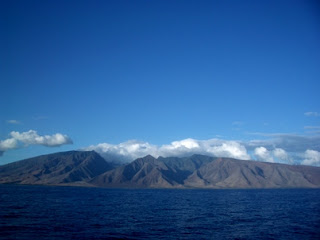As a data manager, my days are slower than the scientists who dive everyday. The cruise around the main Hawaiian Islands is especially busy for the scientists because there are no transit days between the islands. Therefore, hardly anybody is around during the day. Besides 3 meals and occasional exercises to avoid my butt gluing to the chair, my work mainly revolves around the 13.5 inch laptop screen (may be 15). I have to say…it is not as exciting as seeing the marine creatures and sceneries.
A view of the east side of Maui. NOAA Photo by T. Acoba
I cannot describe the underwater world for you, but Maui Island is beautiful from the sea surface. I am excited for the rare opportunities to see the whole island from the ocean. Everyday when we wake up in the morning, the views are different. The east side of the Island, by Hāna, is fully vegetated in various shades of green; we can even see the waterfalls in the distance. The southwest side looks dry, but the landscape with the rugged terrains is astonishing. And then, there is Mount Haleakalā (Hawaiian for House of the Sun), rising imposingly in the distance with the summit cleared from clouds. It is probably obvious how often I take “coffee breaks”.
A view of the southwest side of Maui. NOAA Photo by T.Acoba
My little pleasure at the end of each day is watching the sunset and eating sweets (for most of the time, chocolate). The sunsets are beautiful without a doubt, but the sweets make them so much better. I realized, though, that having time to watch the sunset everyday is a luxury. Maybe very subtle to other’s eyes, but these little things make me come back to be on Hi'ialakai and make sitting in front of the computer a bit more exciting.
Of course, the sunset. NOAA Photo by T. Acoba





Thanks for the post. It is a real treat to get a glimpse of what you see out there. Your photos are spectacular and I hope that you continue to document your above-water experiences so that we all get a better idea about life at sea for a 'data manager'. When you return, hopefully, the photos will be put in a well organized and easily accessible place so that the public can request these fantastic shots. And, it's great to know that even while you are out to sea, you still have access to chocolate.
ReplyDeleteThank you for your comment. Yes, the photos are valid data including the above sea surface shots. We will make sure to handle them properly so that we are ready for the requests from the public audience. By the way, our stewards and the ship store surely know how to make us happy.
ReplyDelete